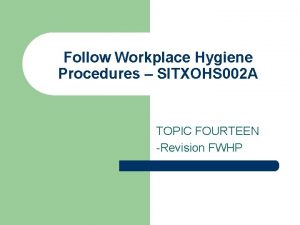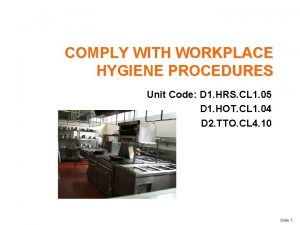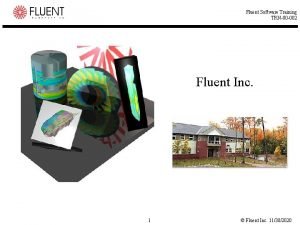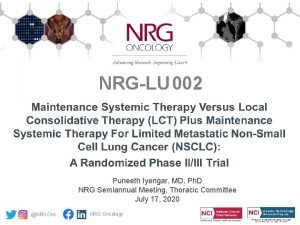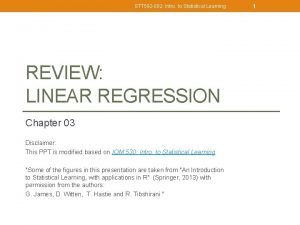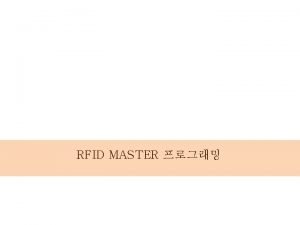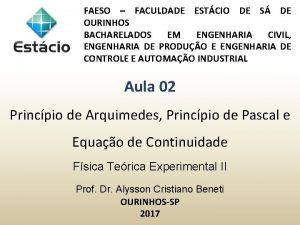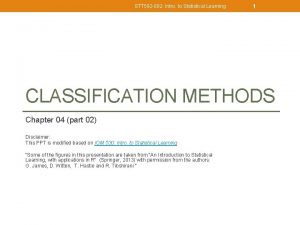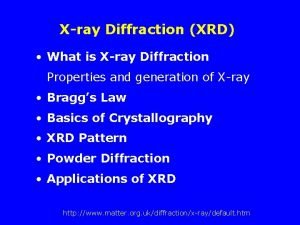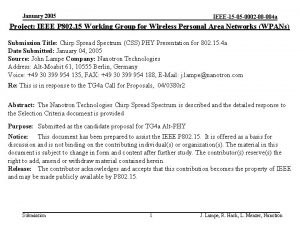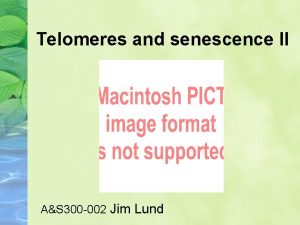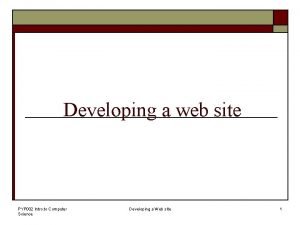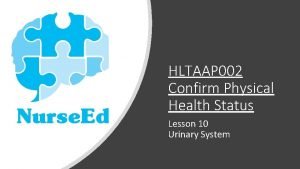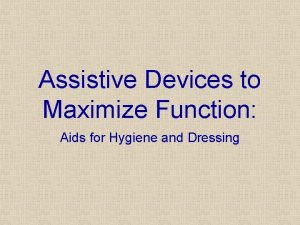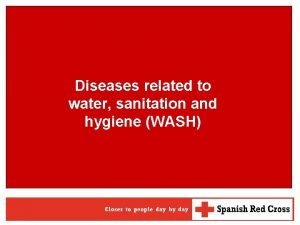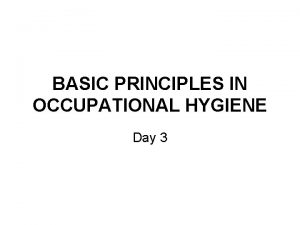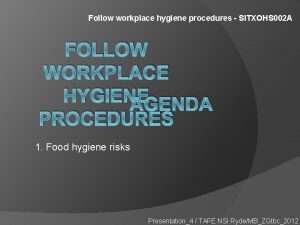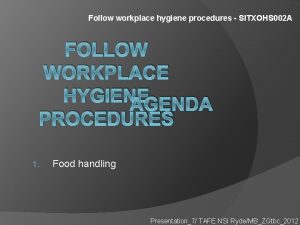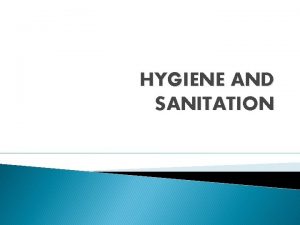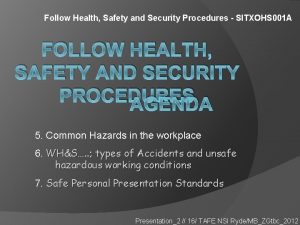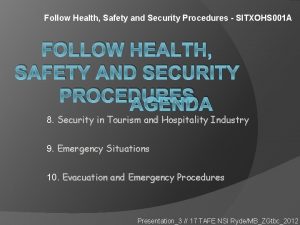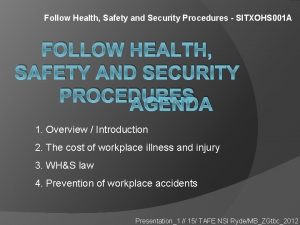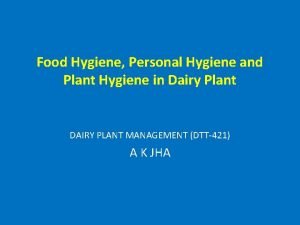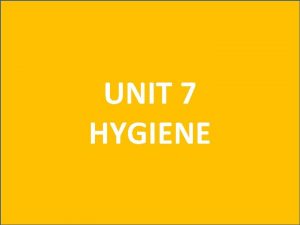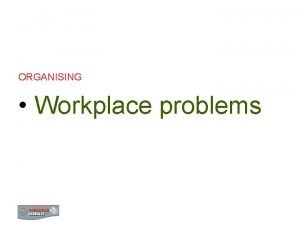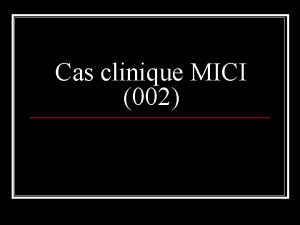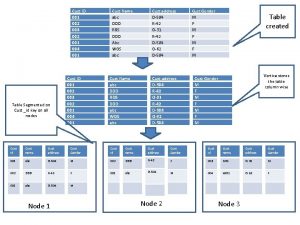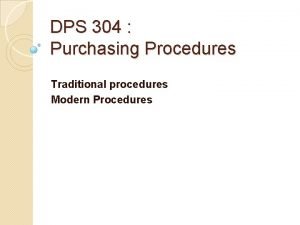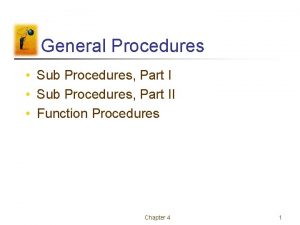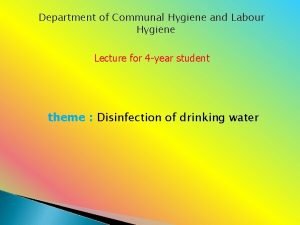Follow workplace hygiene procedures SITXOHS 002 A FOLLOW
































- Slides: 32

Follow workplace hygiene procedures - SITXOHS 002 A FOLLOW WORKPLACE HYGIENE AGENDA 1. PROCEDURES Workplace hygiene and the law 2. Organizational hygiene procedure 3. Why upsurge in food poisoning 4. Enforcement of the food laws Presentation_2 / TAFE NSI Ryde/MB_ZGtbc_2012

TOPIC ONE WORKPLACE HYGIENE AND THE LAW 1. Food Laws in NSW 2. . FSANZ / ANZFA 4 Food Safety Standards (National Code / Standard) 3. Food Safety Legislation and the Food Handler

NSW Food Act 2003 The 2003 NSW Food Act is the main legislation relating to the safe handling of food for sale in NSW. Food Act NSW 2003 � Its main aim is to protect the public health by preventing the sale of contaminated or adulterated food.

Associated Regulations is the NSW Food Regulation 2010 The NSW Food Regulation 2010 states specific requirements for food safety. These Food Safety requirements are based upon the national standards for food safety which are found in Chapter 3 of the Food Standard Code (FSANZ) Food Regulation NSW 2010

Australian Food Standards Code ANZFA Standard 3. 1. 1 Interpretation and Application � This standard Sets out the interpretation provisions that apply to the other food safety standards set out in this Chapter of the Code. The objective of the food safety standards is to ensure that only safe and suitable food is sold in Australia.

Standard 3. 2. 1 Food Safety Programs � This standard is based upon the principle that food safety is best through the identification and control of hazards in the production, manufacturing and handling of food as described in the Hazard Analysis and Critical Control Point (HACCP)

Standard 3. 2. 2 Food Safety Practices and General Requirements � This standard sets out specific requirements for food businesses and food handlers that, if complied with, will ensure food does not become unsafe or unsuitable.

Standard 3. 2. 3 Food Premises and Equipment � This standard sets out requirements for food premises and equipment that, if compiled with, will facilitate compliance by food businesses with the food safety requirements of standard 3. 2. 2 – Food Safety Practices and General Requirements.

Food Safety Legislation and the Food Handler (YOU) Standard 3. 2. 2 – Food Safety Practices and General Requirements outline the most important aspects and requirements for the Food Handler (YOU) and the Food Business. The Standard (3. 2. 2) sets out specific requirements for food businesses and food handlers to ensure that food does not become unsafe or unsuitable.

The Standard 3. 2. 2 specifies process control requirements for each step of the food handling process. � � � Purchasing Storage Cooking Serving Packaging Disposal (Discard) -Receiving -Preparation -Cooling -Display -Distribution -Recall of food

Others relate to the skills and knowledge of Food Handlers, supervisors and Food Businesses: � � � Health and Hygiene of Food Handler Personal Hygiene Cleaning and Sanitizing Maintenance of premises and equipment Garbage / Waste Management Pest Control / Management

TOPIC TWO ORGANIZATIONAL HYGIENE PROCEDURE 1. Hygiene Procedure in Food Preparation 2. The Catering Cycle 3. HACCP (Intro)

Hygiene Procedures in Food Preparation In most professional run hospitality businesses a set rule of Workplace Hygiene Procedures exists. Most of the time in a form such as a Manual and / or Guideline covering all general and very specific aspects of Food Safety and Hygiene Procedures in Food Preparation / Handling. To minimise the risk of food contamination (Food Poisoning) we need to look at all steps involved in food preparation and sales. The “Catering Cycle”

The Catering Cycle TH, C&P_FUTURA_pp 99

HACCP Introduction � HACCP stands for Hazard Analysis and Critical Control Points. � The HACCP concept is a step – by – step approach to the identification and assessment of hazards and risks associated with the manufacture and distribution of products.

HISTORY � HACCP originated in the chemical processing industry in Great Britain. � Then in the 1950’s, 1960’s and 1970’s , the U. S. Atomic Energy Commission made extensive use of the HACCP principles to design nuclear power plants. � The modern concept of HACCP was developed during space missions in the 1960’s by the U. S. Army Laboratories and NASA, mainly to prevent their astronauts from getting sick from the food they were eating in space. � The Phillsbury Company, which was the manufacturer of the food, applied HACCP principles to it’s food operations to ensure the safety of it’s products.

TOPIC THREE WHY UPSURGE IN FOOD POISONING 1. Importance of food / workplace hygiene laws and rules 2. Purpose, urgency, reputation and benefit of food safety program (FSP)

Food Poisoning - Headlines 300 People down with Food Poisoning Health officials say almost 300 people in Hong Kong have suspected food poisoning after eating a traditional Lunar New Year dish. Those affected are complaining of abdominal pain, nausea, vomiting and diarrhea after eating the seasonal dish "poon choi at a New Territory restaurant. The dish features seafood, meat and vegetables cooked together in gravy and is popular during the new year festival, the biggest holiday in the Chinese calendar.

Sydney man dies after eating creamy asparagus sauce Article from: Edith Bevan, the Daily Telegraph Sydney March 27, 2008 09: 58 am A MAN died after eating an asparagus cream-based sauce with fatally high levels of a toxic germ at an awardwinning Sydney restaurant, an inquest has heard.

Why is Food Poisoning on the increase in todays World? -more Restaurants than ever -People go out more than ever -Staff not trained properly on Hygiene issues -Consumption of too many “ready to eat Foods” -and more…. .

Food Poisoning Statistics AUSTRALIA WIDE: -every year ca. 120 people die of Food Poisoning WORLDWIDE -every year ca 1 million people die of Food Poisoning

Importance of Sound Workplace Hygiene Procedures ASK YOURSELF: 1. 2. 3. What would happen if these headlines related to your place of work? Would your customers return if they saw these headlines? Would you want to work for an establishment with such poor standards?

The following and more will be the consequences of “being in the Headlines – Food Poisoning” 1. 2. 3. 4. 5. 6. 7. 8. 9. Loss of customer confidence Bad publicity and loss of reputation Investigation by Health Department Closure of business Financial losses due to wastage, loss of trade, etc… Loss of employment for those working at the establishment Compensation payouts to the people who have become ill Fines and even jail sentences for the owner, manager and staff Illness, injury or death to customers or staff Etc…

How to prevent to become a Headline “Food Poisoning”? Follow Workplace Hygiene Procedures 2. Personal Hygiene 3. Cleaning and Sanitizing 4. Follow the 4 Food Safety Standards (FSANZ) 5. Pest Control 6. Waste Management 7. Maintenance 8. HACCP All these aspects of Hygiene and Food Safety above can be formulated and addressed in a FSP (Food Safety Program) 1.

TOPIC FOUR ENFORCEMENT OF THE FOOD LAWS 1. Federal, State, Council 2. Industry alliances , codes 3. International accreditation Food Hygiene and Safety system(s) HACCP

LEGAL REQUIREMENTS actual in NSW Workplace Health and Safety Act NSW 2011 Regulation NSW 2011 (WH&S) NSW Food Act 2003 NATIONAL Food Standards Australia New Zealand FSANZ 2003 NSW Food Regulation 2010

ENFORCEMENT Ø Local Councils Ø Food Inspectors (Environment / Health Inspectors)

Food Inspectors responsibilities and powers: Provide assistance and advice on all food safety matters � Enter and inspect a food business � Order a clean-up or close a food business � Issuing fines like CAR (Corrective action Report) � To take samples � To prevent the sale of contaminated or adulterated food �

� Industry Codes of Practice Codes of practice provide clear guidelines and procedures to cover a range of issues that apply to a particular industry. Example � Australian Small Goods Food Safety Guidelines. � The Australian Cold Chain � Etc… �

HACCP – International accredited Food Safety and Hygiene Management System HACCP is a legal requirement in almost all countries around the world. It indicated that the particular establishment practices good Hygiene and follows a strict FSP. Today a FSP is a part of the Total Quality Assurance System and Program every establishment has to have in order to stay afloat and competetive. A successful FSP based on HACCP is as well a very successful Money maker / saver and is part of any successful Business Plan.

Process Identify Customer needs & Expectations Brand Protection & Operational Efficiency Risk&Hazard Assessment - Gap Analysis Benchmarking Auditing & Legal Compliance Food Safety Solutions

Food Safety Management System (HACCP based)
 Follow workplace hygiene procedures
Follow workplace hygiene procedures Workplace hygiene procedures
Workplace hygiene procedures Chapter 10 workplace safety procedures
Chapter 10 workplace safety procedures L will follow you wherever you
L will follow you wherever you 002
002 002
002 Puneeth iyengar
Puneeth iyengar 001 002 003
001 002 003 002
002 001 002 003
001 002 003 Mfc-002
Mfc-002 Um objeto com massa de 10kg e volume de 0 002
Um objeto com massa de 10kg e volume de 0 002 002
002 Cip 002-009
Cip 002-009 002
002 002
002 Mu0 processor
Mu0 processor Norsok z-018
Norsok z-018 Oxydization
Oxydization Um objeto com massa de 10kg e volume de 0 002
Um objeto com massa de 10kg e volume de 0 002 Gmas-002
Gmas-002 Semt.002
Semt.002 Cutting speed for cast iron
Cutting speed for cast iron Pressão hidrostática
Pressão hidrostática Semt.001
Semt.001 0,05/0,002
0,05/0,002 002
002 Site structure
Site structure 002
002 Personal hygiene assistive devices
Personal hygiene assistive devices Sanitation and hygiene
Sanitation and hygiene Basic principles of occupational hygiene
Basic principles of occupational hygiene Précautions standard hygiène
Précautions standard hygiène
